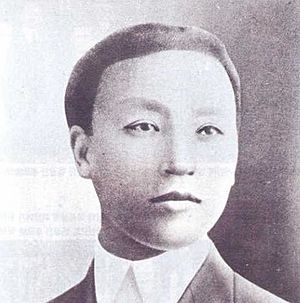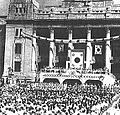Rhee Syng-man facts for kids
Quick facts for kids
Syngman Rhee
|
|
|---|---|
 |
|
| 1st President of the Provisional Government of the South Korea 1st-3rd President of South Korea |
|
| In office April 10, 1919 – 1925 (Provisional Government) July 20, 1948 - May 3, 1960 |
|
| Vice President | Ahn Chang-ho (Provisional Government) Yi Si-yeong |
| Preceded by | The first President (succeeding Emperor Sunjong) Kim Gu (the last President of the Provisional Government) |
| Succeeded by | Park Eunsik (Provisional Government) Yun Po-sun |
| Personal details | |
| Born | March 26, 1875 Hwanghae, Korea |
| Died | July 19, 1965 Honolulu, Hawai`i, United States |
| Nationality | Korean |
- In this Korean name, the family name is Rhee.
Syngman Rhee (born March 26, 1875 – died July 19, 1965), also known as Lee Seungman, was an important Korean leader. He fought for Korea's independence and became the first president of South Korea.
He was president from August 1948 to April 1960. His time as president was often difficult because of the Cold War and tensions in Korea. Rhee was strongly against Communism and led South Korea during the Korean War. He resigned from his position after many people protested against an election they believed was unfair. He later died in Hawaii.
Contents
Syngman Rhee's Early Life and Education
Syngman Rhee was born in Whanghai Province in 1875. His family was part of the important Yangban class. He was a descendant of Prince Hyo-nyong, who was the second son of King Taejong of Joseon.
From a young age, Rhee became involved in Korea's fight against Japanese control. In 1897, he was arrested for protesting against the Korean monarchy. After being released in 1904, he traveled to the United States. There, he studied at universities and earned several degrees, including a Ph.D. from Princeton University. He adopted American customs, even writing his name with his first name before his family name.
In 1910, Rhee returned to Korea under Japanese rule. His political actions quickly caused problems with the Japanese army. Because of this, he left for China in 1912. In 1919, many groups working for Korea's independence came together. They formed the Provisional Government of the Republic of Korea in Shanghai. Rhee was chosen as its president. He held this role until 1925, when he was removed for misusing his power.
Becoming the First President of South Korea
After World War II ended, Rhee returned to Seoul. He was well-known to the Allied powers, which helped him return before other independence leaders. In 1945, he was chosen to lead a temporary government. With the quiet support of the American forces occupying Korea, Rhee took steps to "remove Communism." This was also a way for him to get rid of anyone who might oppose him.
Rhee was elected the first president of South Korea on May 10, 1948. He won by a vote in the parliament, beating Kim Koo. Many left-wing political groups did not take part in this election. On August 15, 1948, he officially took over power from the U.S. military. This made him the legal leader of the Korean people.
As president, Rhee gained a lot of power, even before the Korean War began in 1950. He allowed a special security force, led by his close associate Kim Chang-ryong, to arrest and mistreat people they thought were Communists or agents from North Korea. His government was also involved in several tragic events where many people died. The most well-known was on Jeju Island, after an uprising by left-wing groups. While similar events happened under later governments, they were not as widespread.
The Korean War and Rhee's Actions
Rhee became unpopular when the Korean War started. He told people in Seoul to stay in the city, but he had already left himself. His decision to destroy the bridges over the Han River stopped thousands of people from escaping from the Communists.
The UN and South Korean forces fought back, pushing the North Koreans north. However, a counterattack from China pushed the UN and South Korean forces back to the current DMZ. Rhee became unpopular with the U.S. and the UN because he refused to agree to peace plans that would have kept Korea divided. He wanted to unite Korea under his leadership with UN help. He tried to stop any peace plan that did not completely remove the northern government. He also wanted stronger military action against China.
On January 18, 1952, Rhee declared that South Korea controlled the waters around the Korean peninsula. This was similar to today's exclusive economic zones. This new border, which Rhee called the "Peace Line", included Tsushima Island and the uninhabited islands known as Dokdo. This caused protests from the Japanese government, who said the islands were theirs. There were minor clashes, but the islands have been controlled by South Korea ever since.
Throughout his time in power, Rhee took extra steps to keep control of the government. In May 1952, he pushed for changes to the constitution. These changes made the presidency a position directly elected by the people. To get this passed, he declared martial law and jailed members of parliament he thought would vote against it. Rhee was then easily re-elected. He also regained control of parliament in the 1954 elections. He even changed the constitution to remove the eight-year limit on how long a president could serve, allowing himself to stay in power longer.
In the 1956 presidential election, Rhee's chances of winning again seemed low. People felt he should not be allowed to be president three times. The main person running against him, Shin Ik-hee, attracted large crowds. However, Shin's sudden death during the campaign allowed Rhee to win easily. The person who came in second, Cho Bong-am, was later accused of spying and executed in 1959.
Rhee's Resignation
By 1960, Rhee had already served three terms as president. His next victory seemed certain after the main opposition candidate, Cho Byeong-ok, died just before the March 15 elections. Rhee won with 90% of the votes. The real competition was for vice president, which was elected separately. Yi Gi-bung, whom Rhee wanted to take over after him, was declared the winner. However, the opposition claimed the election was rigged. This made many Koreans very angry. A student-led protest movement, called the April 19 Movement, forced Rhee to resign on April 26.
On April 28, a plane operated by the CIA took Rhee out of South Korea to protect him from the angry crowds. It was later revealed that President Rhee had misused government money for himself. Rhee, his wife Francisca Donner, and their adopted son lived in exile in Honolulu, Hawaii. Syngman Rhee died on July 19, 1965, from a stroke. His body was returned to Seoul and buried in the National Cemetery on July 27, 1965.
Syngman Rhee's Legacy
Syngman Rhee's impact on Korea is still debated today. Generally, people who hold conservative views see Rhee as a founding father of the nation. However, those with more liberal views often criticize his actions.
Rhee's former home in Seoul, Ihwajang, is now a museum dedicated to him. The Woo-Nam Presidential Preservation Foundation was also created to honor his memory.
Syngman Rhee in Songs and Movies
- Rhee is mentioned in Billy Joel's song "We Didn't Start the Fire", which talks about historical events.
- Rhee is also mentioned several times in Robert Altman's movie MASH (1970). This comedy is about American army doctors during the Korean War.
- In one scene, when the lights go out during surgery and then come back on, a doctor jokes, "Syngman Rhee paid the electric bill."
- Another time, when a doctor takes a young Korean boy for medical treatment, he tells the guards, "This is Syngman Rhee's son, he goes right in," so they don't have to wait.
Related pages
- Kim Gu
- Kim Kyusik
- Kim Seong-Su
- Yun Poson
- Yun Chi-Young
- Chang Myon
- Kim Won-bong
- Kim Il-Sung
- Park Hon-Yong
- Heo Jeong
- Yun Chi-Ho
- Park Chung-hee
- Philip Jaisohn
Images for kids
-
Rhee and American general Douglas MacArthur at the ceremony for the new government of Republic of Korea
-
Rhee with President of the Republic of China Chiang Kai-shek in 1949
-
Rhee and his wife with Army Corps of Engineers staff in 1950 at the Han River Bridge
-
Rhee on the cover of Time magazine, 1953
See also
 In Spanish: Syngman Rhee para niños
In Spanish: Syngman Rhee para niños








